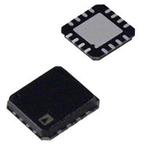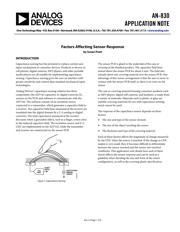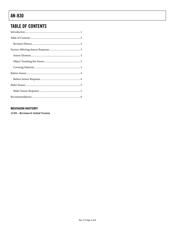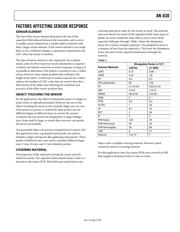下载

AN-830
APPLICATION NOTE
One Technology Way • P.O. Box 9106 • Norwood, MA 02062-9106, U.S.A. • Tel: 781.329.4700 • Fax: 781.461.3113 • www.analog.com
Rev. 0 | Page 1 of 8
Factors Affecting Sensor Response
by Susan Pratt
INTRODUCTION
Capacitance sensing has the potential to replace current user
input mechanisms in consumer devices. Products as diverse as
cell phones, digital cameras, MP3 players, and other portable
media players are all suitable for implementing capacitance
sensing. Capacitance sensing gives the user an interface with
greater sensitivity and control than standard mechanical input
technologies.
Analog Devices’ capacitance sensing solution has three
components: the AD7142 capacitive-to-digital converter IC,
sensors on the PCB, and software to communicate with the
AD7142. The solution consists of an excitation source
connected to a transmitter, which generates a capacitive field to
a receiver. The capacitive field lines measured at the receiver are
translated into the digital domain by a Σ-Δ analog-to-digital
converter. The total capacitance measured at the receiver
decreases when a grounded object, such as a finger, comes close
to the induced capacitive field. The excitation source and Σ-Δ
CDC are implemented on the AD7142, while the transmitter
and receiver are constructed on the sensor PCB.
05849-001
EXCITATION
SIGNAL
240kHz
Σ-Δ
ADC
16-BIT
DATA
TX
RX
Figure 1. Capacitance Sensing
The sensor PCB is glued to the underside of the case or
covering of the finished product. The capacitive field lines
extend above the sensor PCB for about 4 mm. The field also
extends above any covering material over the sensor PCB. One
advantage of this sensor arrangement is that the user is never in
contact with the sensor PCB itself, so there is no wear on the
sensor.
The case or covering material housing consumer products such
as MP3 players, digital still cameras, and handsets, is made from
a variety of materials. Materials such as plastic or glass are
suitable covering materials for use with capacitance sensing;
metal cannot be used.
The response of the capacitance sensor depends on three
factors:
• The size and type of the sensor element
• The size of the object touching the sensor
• The thickness and type of the covering material
Each of these factors affects the magnitude of change measured
by the CDC when the sensor is touched. If the change in CDC
output is very small, then it becomes difficult to differentiate
between the sensor-touched and the sensor-not-touched
conditions. This application note details how each of these
factors affects the sensor response and can be used as a
guideline when deciding the size and form of the sensor
configuration, as well as the covering plastic specification.








